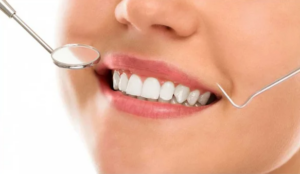Can Porcelain Veneers Be Whitened? This is a common question among individuals who have undergone porcelain veneer procedures. Traditional tooth whitening methods are typically effective only on natural teeth, as porcelain veneers have a distinct composition. So, are there any methods to help porcelain veneers maintain their pristine white appearance? Let’s explore this topic with Joy International Dental Clinic in the article below.
1. What is the Porcelain Veneer Procedure?

Porcelain veneers are a popular cosmetic dental procedure that helps restore the beauty and functionality of teeth. It is a safe and effective solution for individuals experiencing issues such as tooth discoloration, chips, gaps, or damage due to cavities or trauma.
During the procedure, a thin layer of the natural tooth’s surface is gently removed. Then, a custom-made porcelain veneer, matching the shape and color of your natural teeth, is placed over the prepared tooth. This not only provides a brighter, more radiant smile but also protects the underlying natural tooth from external factors. Additionally, it restores comfortable and efficient chewing function.
2. Causes of Porcelain Veneer Discoloration
2.1 Dietary Habits

Although porcelain veneers exhibit better stain resistance compared to natural teeth, consuming deeply pigmented foods and beverages like coffee, tea, red wine, sugary drinks, or foods containing artificial coloring can still cause them to discolor over time. Smoking is also a major culprit that contributes to the loss of natural whiteness in porcelain veneers.
2.2 Inadequate Oral Hygiene

Improper oral hygiene practices can accelerate the discoloration of porcelain veneers. Brushing too vigorously or using abrasive toothpaste can scratch the veneer’s surface, making it more susceptible to plaque accumulation and gradual discoloration. Neglecting oral hygiene practices like flossing and using mouthwash allows bacteria to thrive, affecting both natural teeth and porcelain veneers.
2.3 Gum Disease

Weak gums, periodontitis, or issues with the soft tissues surrounding the teeth can make porcelain veneers appear less vibrant. When gums are inflamed, the gum line between the veneer and the natural tooth may recede, exposing the underlying natural tooth. This can create an uneven color appearance. If left untreated, this condition not only affects aesthetics but also reduces the longevity of the porcelain veneers.
3. Can Porcelain Veneers Be Whitened?
3.1 The Truth About Whitening Porcelain Veneers

Many people consider teeth whitening when they notice their porcelain veneers becoming yellowed or discolored, hoping to restore their original brilliance. However, unlike natural teeth, porcelain veneers cannot be whitened using conventional methods. This is because porcelain veneers are made from solid porcelain material or have a protective glaze that, while preventing staining, also prevents whitening agents from penetrating and working effectively.
If porcelain veneers become discolored, the only solution is to polish the surface to some extent. In cases of significant discoloration, replacing the veneers with new ones may be necessary. To prevent this issue, it’s best to maintain a proper oral hygiene routine, limit consumption of staining foods and beverages, and visit your dentist regularly to keep your porcelain veneers bright, beautiful, and long-lasting.
4. How to Care for Your Porcelain Veneers and Extend Their Lifespan
To ensure the longevity and beauty of your porcelain veneers, proper care is essential. Despite their strength, porcelain veneers still require protection. Here are some tips to help you maintain their brilliance and extend their lifespan:
-
Brush Correctly: Use a soft-bristled toothbrush and gently brush in a vertical or circular motion to avoid damaging the gums and the porcelain veneer’s surface. Remember to replace your toothbrush regularly!
-
Floss and Use Mouthwash: Brushing alone is not enough. You should also use dental floss to remove plaque from between your teeth and rinse with a saline solution or specialized mouthwash to maintain a clean oral environment.
-
Limit Staining Foods and Beverages: Coffee, tea, red wine, and deeply colored foods can stain your porcelain veneers over time. If you consume these items, rinse your mouth or brush your teeth afterward to minimize the risk of staining.
-
Avoid Biting on Hard Objects: Although porcelain veneers are durable, biting directly on ice, hard bones, or using your teeth to open bottles can chip or damage them. Use your teeth properly to protect your smile!
-
Regular Dental Check-ups: Don’t forget to schedule dental check-ups every six months. This allows your dentist to detect any issues early on and helps you maintain healthy and beautiful porcelain veneers for years to come.
Conclusion
Joy International Dental Clinic has provided answers to your questions about whether porcelain veneers can be whitened. We hope this article has given you a clearer understanding of the issue and provided you with the knowledge to care for your porcelain veneers properly. If you have any further questions, please leave a comment below for a prompt response.






